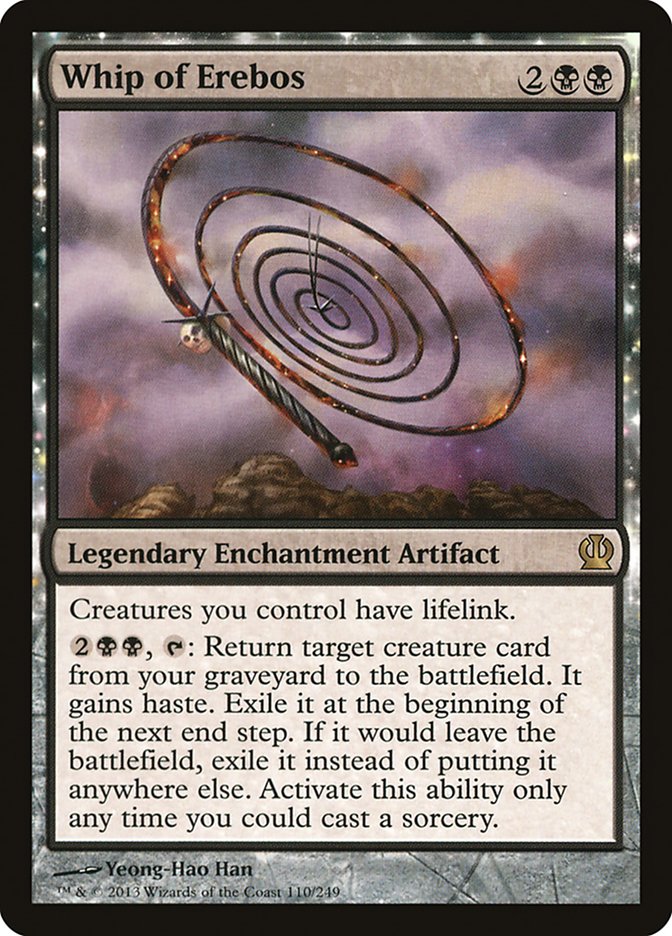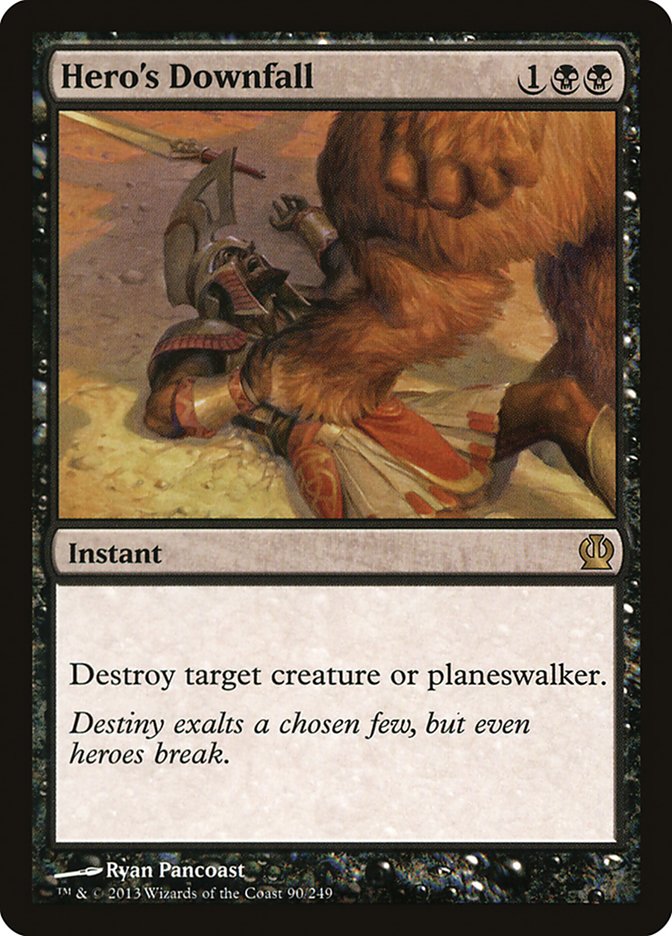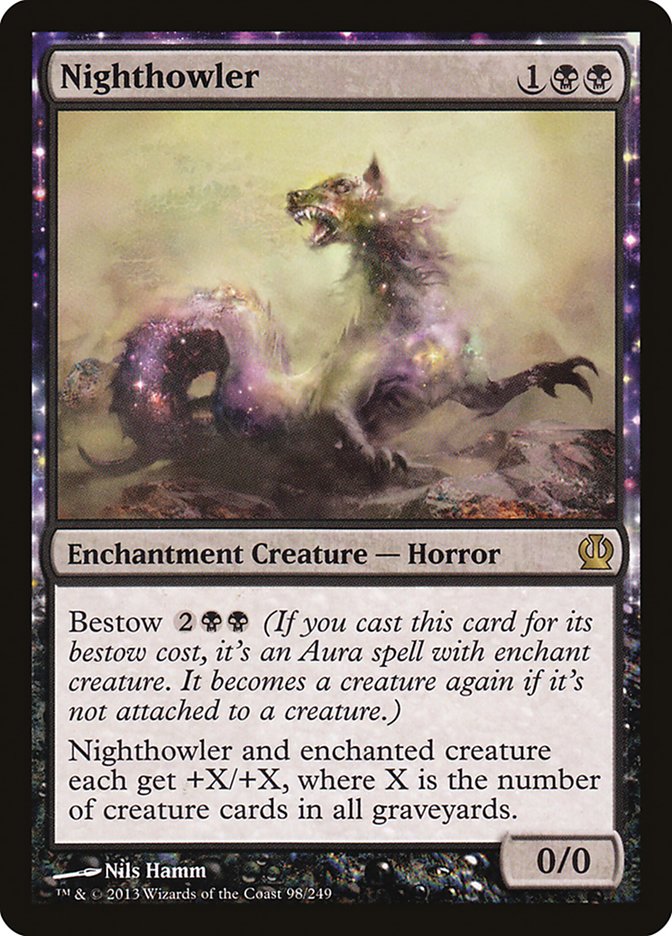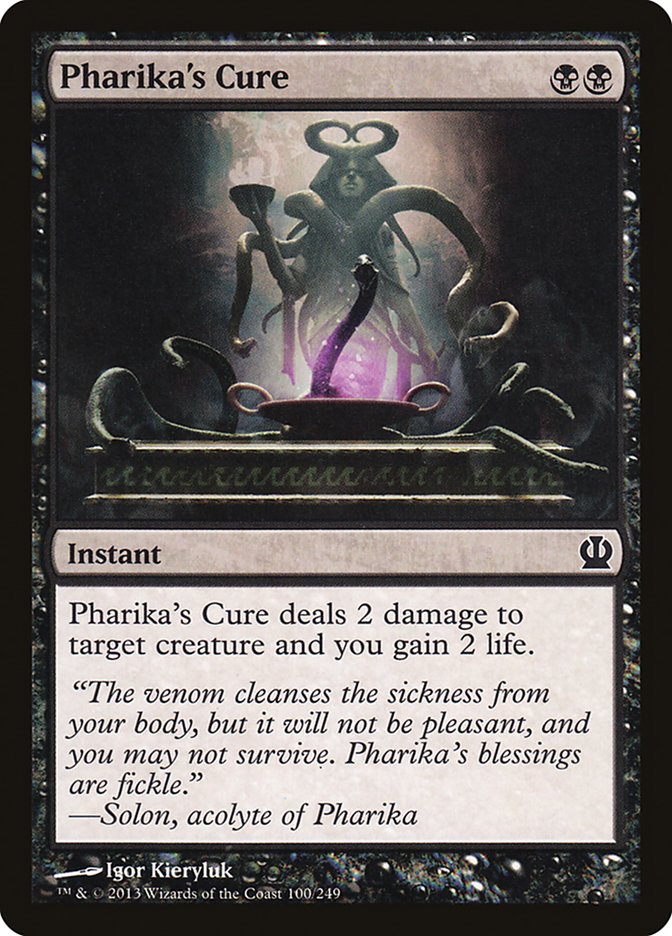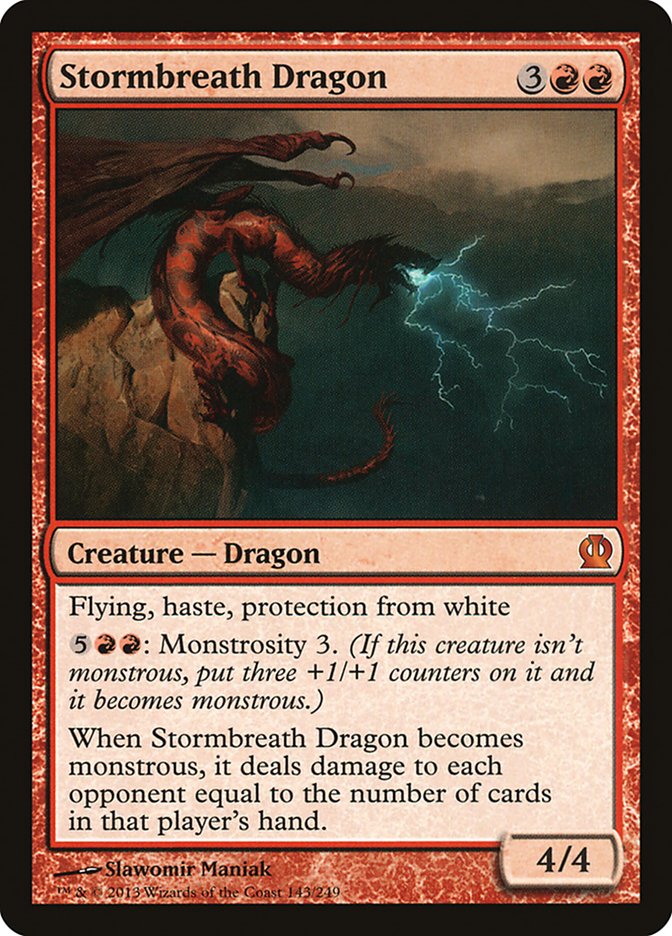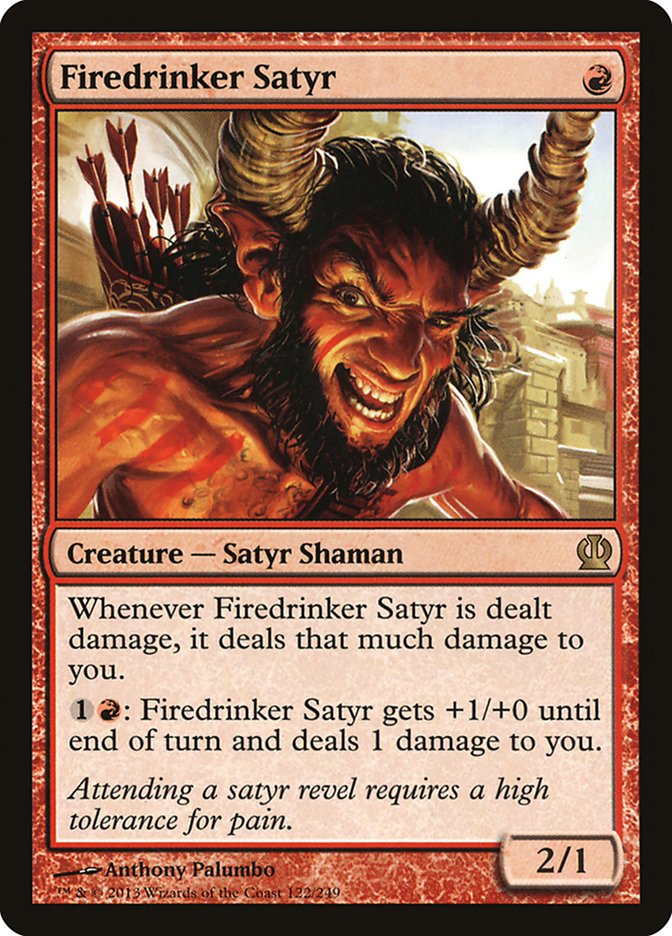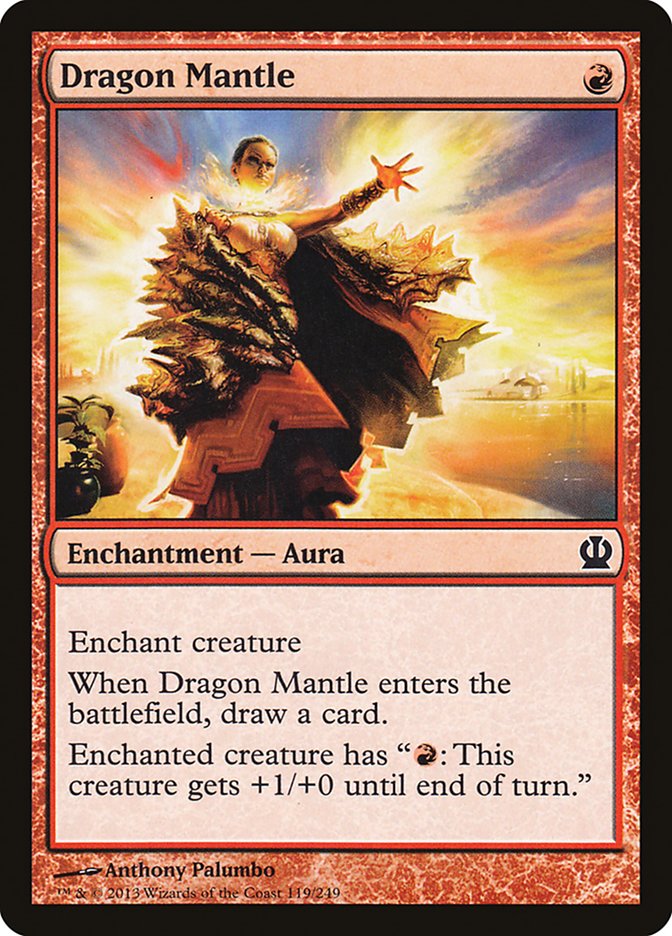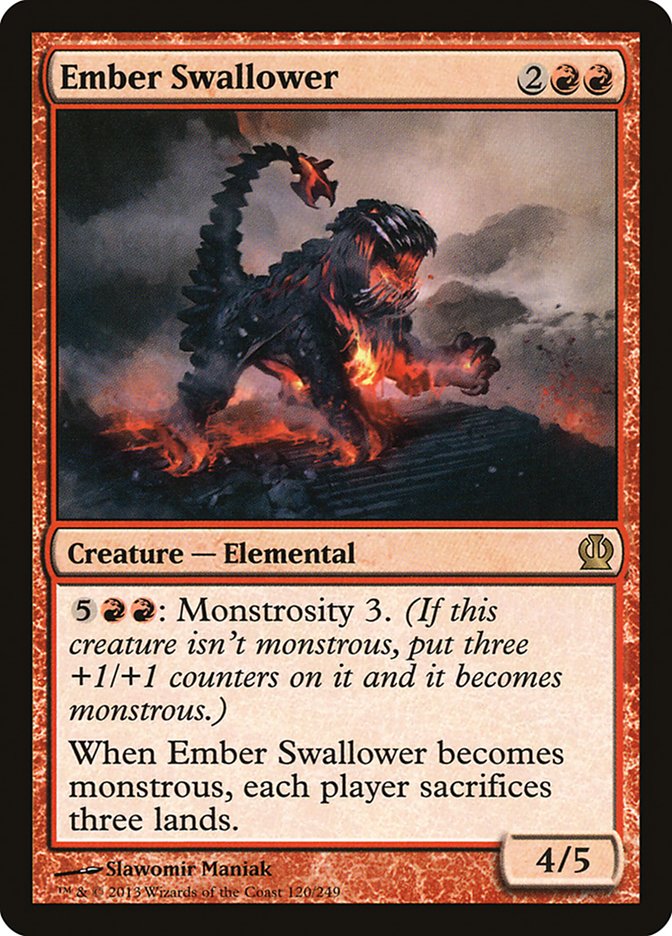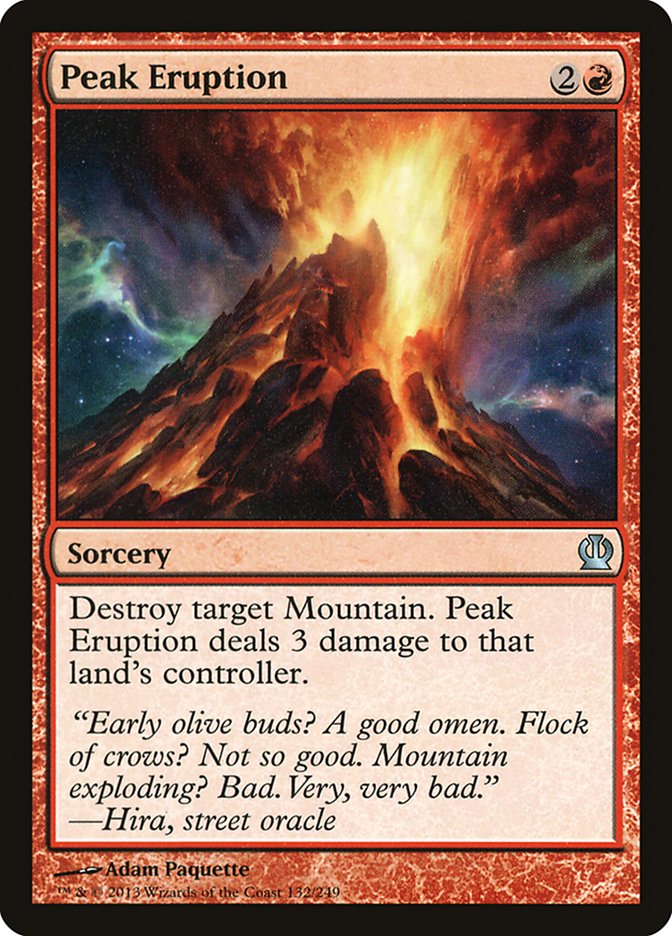Theros is finally here and brings with it my absolute favorite time of the year for Magic: the fall rotation. It’s not just hundreds of awesome new cards to work with; it’s that four sets rotating out at once makes a lot of the other cards in the format playable that didn’t used to be. It’s a brand-new world to explore, and while Innistrad block, Thragtusk, and Thundermaw Hellkite are all awesome, I am really looking forward to the exciting and unknown new format. This time of year is so awesome that I can’t help wonder if it’d be possible to do it twice a year.
Regardless, now that we’re here, I’m loving it, and Theros looks freaking sweet. As I’ve already written seven articles on it, I’d like to dive straight into brewing with the new cards. Today, I’ll be discussing the top Theros cards in black and red and building decks with all of them, moving on to the other colors next week. Obviously, an awful lot of decks are multicolor, so there is going to be plenty of overlap.
Up first, darkness . . .
Top 5 Black Theros Cards
5. Tormented Hero
4. Whip of Erebos
3. Read the Bones
2. Hero’s Downfall
1. Thoughtseize
Honorable Mentions: Agent of the Fates, Nighthowler, Pharika’s Cure
It’s interesting that black’s top cards are a nice variety, though not a lot of creatures.
Thoughtseize is quite the controversial card. First of all, a lot of people don’t play it right. Reid Duke Thoughtseize You article does an excellent job of breaking down how to actually play it correctly and when to look for it being in the wrong places. It’s definitely required reading.
It also has quite a number of critics due to the lack of counterplay and how much it stops people from trying to actually do anything out of the norm. That said, its power level is quite high, and like Mana Leak or Lightning Bolt being in Standard, it will be a defining component of the game during its entire life in the format.
It’s not the type of card that you just want four of in every deck, but having access to them in a black deck after sideboarding is basically a must. I am definitely more on the Gerry Thompson side in terms of maindecking some. Yes, you’ll generally board them out against Mono-Red Aggro, but that’s true about a lot of cards. It’s not like Thoughtseize is ever dead. Standard has highly variable power levels on cards, so taking the best ones is a big game. Additionally, there is a real shortage of one-drops, so good one-mana plays are at a premium.
People seem to have a wide range of views on Read the Bones. Is it just worse than Divination, as Todd Anderson claimed? Is it the truth, as Gerry Thompson suggested?
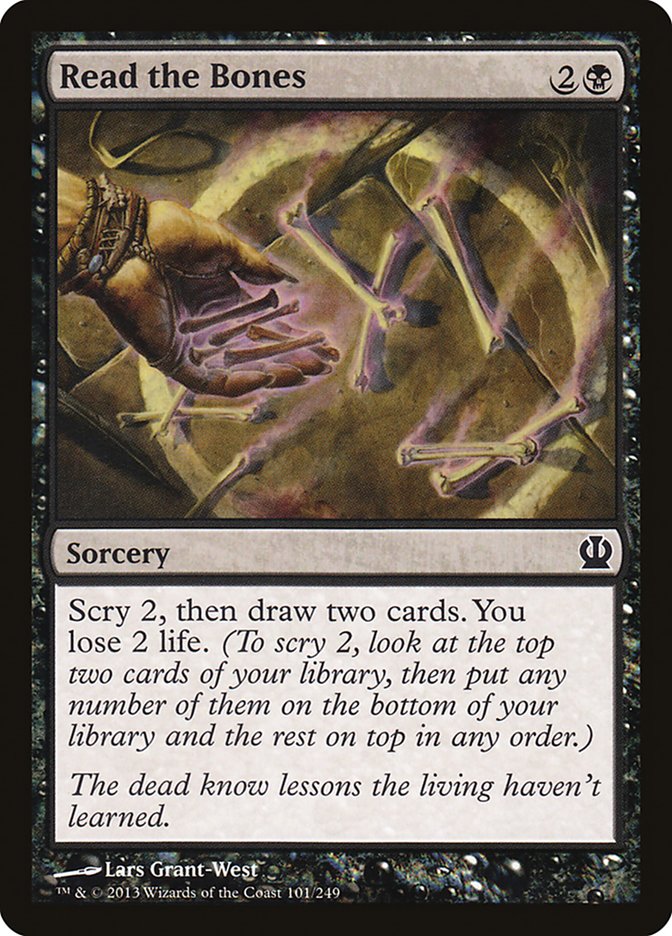 |
vs. |
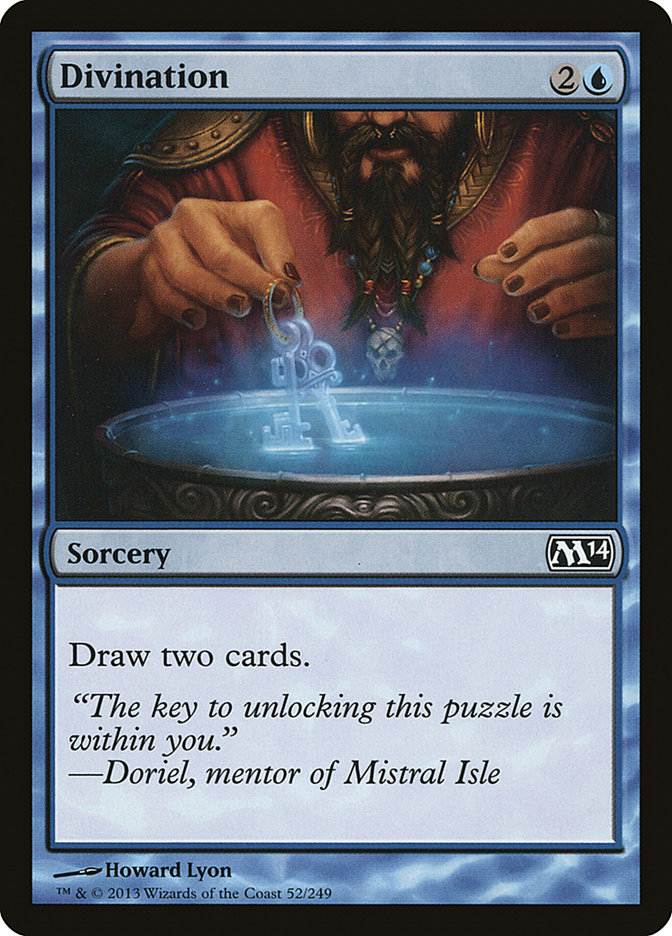 |
The card is awesome; Gerry is completely right. It’s not actually one of those places where the answer lies somewhere in between. As long as you are using the card the way it is supposed to be used, it’s more powerful than Divination, and I love Divination more than most.
First of all, Night’s Whisper and Sign in Blood have been consistently good. This is one mana more than Night’s Whisper in exchange for scry 2. How good is that?
Preordain is one mana for scry 2. That’s literally all it does besides draw a card to replace the card it cost you. That card is broken.
So how good is Night’s Whisper? It’s basically just Night’s Whisper, where one of the cards you draw is a Preordain you have to play that turn. There is a lot of room for a card to be better than Night’s Whisper, but let’s just be clear that this more than just a notch above it.
As for Divination? Well, obviously you are paying two life for scry 2, which is contextual, but there is more going on. You get Divination in black! Just as Harmonize was much, much better than Concentrate, so too is Divination better in black than blue. This is primarily because blue has such a plethora of good options and is balanced around it having good card draw. Black, like green, is balanced differently.
How good is Doom Blade for black? It’s good but nothing special at all. It’s very easy to not play it, as you have plenty of other options. Now imagine if blue got Doom Blade!
Whip of Erebos is a pretty awesome new type of card that does a couple things we really value. First of all, there are a lot of great ways to pay life (considering we just talked about Thoughtseize and Read the Bones). Second, there are a lot of aggressive cards in the new format. Giving all of your creatures lifelink immediately with no mana investment needed each turn is massive.
Second, being able to get creatures back is a form of card advantage, and black could really use a Tome. Maybe your opponent is playing a lot of counterspells and removal, but at least each of your guys gets to hit once. This isn’t just extra damage. Because your guys all have lifelink, you gain a lot of extra life this way even if they are blocked. I would have ranked it higher, but being legendary (and not a creature, so dying a lot less often) really limits just how much we can exploit it.
Here’s an archetype that is sure to become a fixture in the tier 1 metagame and possibly the deck to beat in the first week:
Creatures (8)
Planeswalkers (4)
Lands (19)
Spells (29)

R/B/W started as a Block deck but struggled a bit with control, which proved to be one of the pillars of the format. It gains a ton from M14 and Theros, with not only Thoughtseize, Read the Bones, and Whip of Erebos (all of which are great against control) but also Chandra, Pyromaster; Elspeth, Sun’s Champion; Anger of the Gods; Chained to the Rocks; the Temples (which are awesome in here); and plenty of great sideboard options.
The idea is similar to Jund decks of recent years. You just play some good creatures and good planeswalkers while killing everything your opponent plays. You have discard for disruption and to win attrition-based battles. One big advantage R/B/W has over old Jund decks is how much better it is at drawing cards. One weakness is a less good mana base, losing cards like Farseek (Rakdos Keyrune is just not the same) and Kessig Wolf Run (or man lands) as well as worse life gain.
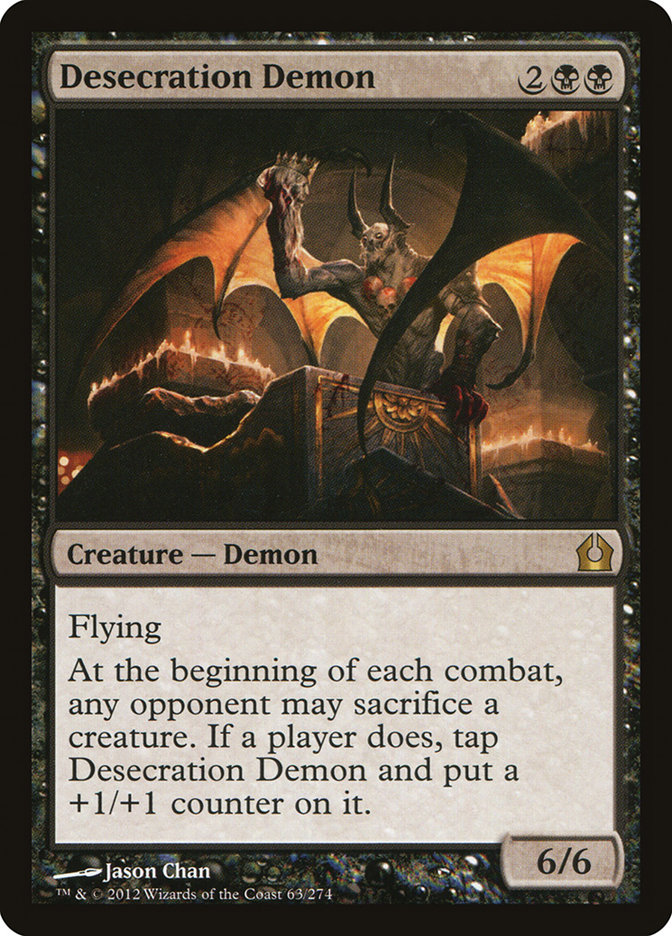 |
vs. |
 |
While Desecration Demon has been in style recently, I prefer Alms Beast in decks like this. It is a more reliable blocker; the life it gives is not a big deal; the lack of flying doesn’t matter too much; it costs just single black (which matters when we want to support Boros Reckoner and use Temples instead of Guildgates); and finally, it’s just way, way better with Whip of Erebos.
One of the real challenges is figuring out what to do with your first two turns. You have no shortage of awesome three-, four-, and five-mana plays (plus sixes and sevens if you want them), but you don’t want to plan on your first play being turn 3 against aggro if you can avoid it.
While Hero’s Downfall is one of the Top 5 black cards in Theros, I avoid it here because of just how glutted we are at the three spot. Warleader’s Helix is another one that got trimmed for curve considerations, but it may be that the life gain is too necessary.
Hero’s Downfall is a tricky one because while it is a strict upgrade on Murder, that isn’t exactly as good as we can do. There are also an awful lot of awesome three-mana plays in the format, so often we can do better. That said, it’s still a quality card.
Here’s an archetype I like Hero’s Downfall in:
Creatures (4)
Planeswalkers (3)
Lands (18)
Spells (36)
- 5 Plains
- 4 Island
- 1 Last Breath
- 2 Syncopate
- 2 Doom Blade
- 2 Ratchet Bomb
- 4 Azorius Charm
- 4 Supreme Verdict
- 2 Detention Sphere
- 3 Sphinx's Revelation
- 3 Far
- 2 Hero's Downfall
- 2 Dissolve
Sideboard

It’s not clear if adding black is worth the pain (both from shock lands and from Burning Earth), but it is at least worth exploring. Thoughtseize (and Duress, Sin Collector, Psychic Intrusion, and Reap Intellect) adds a very valuable dimension to control mirrors.
Hero’s Downfall goes a long way towards addressing classic control problems, such as Domri Rade.
As an added bonus, Temples work great in slow decks!
As for Tormented Hero?
Creatures (21)
- 4 Rakdos Cackler
- 4 Spike Jester
- 4 Akroan Crusader
- 4 Tormented Hero
- 4 Agent of the Fates
- 1 Firedrinker Satyr
Lands (13)
- 9 Swamp
- 4 Blood Crypt
Spells (26)

The Rakdos Heroes lead you to play a little more sorcery speed action, for targeting your guys (rather than the +1/+1 counters white uses). It’s not clear you want this many auras, but I do love how well Auger Spree works in here, giving you removal, an enabler, and a big damage boost all in one.
Agent of the Fates helps give us even more removal despite not playing many dedicated removal spells. If dedicated Heroic black is a thing, Agent of the Fates is probably why, but I gave the edge to Tormented Hero since two power for one is even more likely to be a thing.
Pharika’s Cure is just a niche role player if you need some help against fast aggro. The life it gains is much appreciated, as Thoughtseize and Read the Bones have us paying life more often than usual.
Overrated black card of the set? Erebos, God of the Dead. He is certainly not unplayable, but stopping life gain is not that big an impact on the game, paying two life and two mana for an extra card is nowhere near as good as Underworld Connections, and that leaves us needing to consistently get the body to make him worth it. Maybe a black devotion deck will emerge and he will play a part, but just throwing him into random decks is not a great move.
Top 5 Red Theros Cards
5. Firedrinker Satyr
4. Magma Jet
3. Stormbreath Dragon
2. Forge[/author]“]Purphoros, God of the [author name="Forge"]Forge[/author]
1. Anger of the Gods
Honorable Mentions: Hammer of Purphoros, Dragon Mantle, Lightning Strike, Ember Swallower, Akroan Crusader, Peak Eruption
The best red cards in Theros go into basically two kinds of decks: the Anger of the Gods decks and Firedrinker Satyr / Purphoros decks. Oh sure, Magma Jet and Stormbreath Dragon go everywhere, but in general red can be used aggressively or more midrange/control.
Anger of the Gods number one? Above Purphoros and Stormbreath Dragon?
To begin with, the card is awesome. Slagstorm was awesome, and this one exiles Voice of Resurgence. Second, it is what we really, really need right now. There are tons of ways to deal two damage, so three is little bit the magic number. Third, being a turn faster than Supreme Verdict is really valuable.
Anger of the Gods is so good that I think it has good chances of propelling U/R or U/R/X Control up to tier 1. U/W has been the default control base for as long as Sphinx’s Revelation and Supreme Verdict have reared their ugly heads. Opportunity in M14 helps make up for Sphinx’s Revelation, and now Anger of the Gods helps make up for Supreme Verdict.
Creatures (4)
Planeswalkers (3)
Lands (10)
Spells (43)

We still miss Detention Sphere, but at least Ratchet Bomb helps in terms of being able to deal with miscellaneous permanents.
Two major weaknesses that remain are the lack of life gain and difficulty with large creatures. The life gain is partially addressed by having more cheap removal and trying to just not fall behind. Magma Jet is generally a better card that Shock, but we may want some one-mana plays just for added tempo.
Speaking of Magma Jet, it is an awesome card and should be played if only because of its rate; however, it is not the best-positioned card in the format. There are lots of ways to deal two, and a lot of creature choices will be made to try to avoid this weakness.
Still, it kills a lot of creatures people play, and scry 2 is right around half a card’s worth of value. Magma Jet helps smooth out our draws early and digs us to gas later. I could easily see the format go a direction where four Magma Jets is standard operating procedure.
Yes, there is only one Steam Augury in here, but that is not just to show the card off. The second one really was my last cut. I was just fighting to keep the curve down, and the addition of Prognostic Sphinx requires some considerations. Of course, the Sphinx works particularly well with Steam Augury, as it leads us to having a higher percentage of cards we don’t want (which make ideal fuel).
How good is Steam Augury? It’s kind of an instant-speed draw 2.25 that incentivizes you to play a very homogeneous deck (just like Thoughtseize does). An in-depth look at Steam Augury (and the “math” behind it) can be found here.
Young Pyromancer is excellent, but I am hesitant to use it in decks with few creatures, as people play a fair bit of removal for it in Standard. If our only creatures were Aetherlings and Sphinxes, we would make their dead cards good. By sideboarding it, we sidestep most of these problems. Of course, if everyone moves away from removal, it becomes a superstar.
Stormbreath Dragon also makes an appearance here, this time in the sideboard. A lot of people are quick to like the Dragon because of how much it resembles Thundermaw Hellkite (my, how perspectives change . . . ), but it really is quite good and actually even more of what a control deck wants out of the sideboard.
Having protection from white is pretty valuable right now due to cards like Azorius Charm, Detention Sphere, Chained the Rocks, and more. Additionally, it is going to become monstrous quite often, making him hit like a ton of bricks. A 7/7 plus a Sudden Impact is often going to be game, but sometimes it’s just a nice way to deal with a planeswalker (or two!). Control decks make better use of his monstrous ability than, say, a red aggro deck if only because they actually hit seven more often.
However, it isn’t just blue control decks that benefit from it as a mana sink. Stormbreath Dragon is a worthwhile consideration for the R/B/W deck above, but it actually becomes a primary win condition when the deck strips white and goes full-on Machine Head:
Creatures (8)
Planeswalkers (3)
Lands (19)
Spells (30)

GerryT wrote about this style of B/R yesterday, including a decklist that was almost exactly where I had arrived following the exact same logic. That we both independently arrived at such similar lists lead me to believe a lot of people are going to try something similar early on.
This list is quite similar to the R/B/W version, basically just using the next-best cards available to make up for the loss of the white cards. The harshest loss in my opinion is that of Boros Reckoner. It just looks so good in the new format, with the right-sized body and its impact against aggressive strategies.
Why R/B Midrange? Because normally it doesn’t get card draw as good as Chandra, Pyromaster and Read the Bones, it normally doesn’t get such a good sweeper (Anger of the Gods), and it normally doesn’t get so much good discard. It even has good ways to close out the game!
Stormbreath Dragon isn’t just for slow decks however:
Creatures (24)
- 4 Chandra's Phoenix
- 4 Ash Zealot
- 4 Rakdos Cackler
- 4 Young Pyromancer
- 2 Purphoros, God of the Forge
- 2 Stormbreath Dragon
- 4 Firedrinker Satyr
Lands (4)
Spells (32)
Sideboard

This is a very “normal” red aggro deck as opposed to the Burning-Tree Emissary approach (which we’ll also see a lot of). Playing a fair bit of burn makes Firedrinker Satyr better, but more importantly it opens up Young Pyromancer.
Firedrinker Satyr is a better Jackal Pup, but all of the creatures around are better. It’s still a two-power one-drop, which is exactly what red wants, and honestly, we’d play it even if it was just Jackal Pup. That it gives you something to do with your extra mana and hits even harder is exactly what makes the card excellent. On balance, it should be noted that it is much better when you play burn (to clear a path for it); mono-creature decks will not be getting full value out of it.
Why only two Purphoros? I’m a little hesitant about just jamming a ton of copies of a slow, indestructible legend into a red aggro deck. The card’s power is very, very high, but we want to be careful not to get too greedy. The right number could easily be three (or even four), but I want to start at a spot where I am happy to see the guy.
Why is Purphoros so strong on power level? An in-depth analysis can be found here. The cliffs notes version is that he can often being an indestructible source of two points of damage a turn right off the top. Then the pump ability gives you a mana-efficient way to use your mana for extra damage every turn. Finally, when he does wake up, he hits like a sledgehammer.
Now, it should be noted that Purphoros is better the more creatures you play, which means that when we play this much burn, we are getting a little less out of him (contributing to my decision to play just two).
There are plenty of other possible ways to use Purphoros, such as with token making, which pays you from both of his abilities. Elspeth, Sun’s Champion is particularly well-suited for this, paying you triple on both abilities (each turn!).
Dragon Mantle may surprise a lot of readers, but I think the card is really underrated. Adding draw a card to a one-mana spell goes a long way, and Dragon Mantle actually does a few things we want.
First of all, it contributes to devotion. A one-mana cantrip that gets you one closer is already a pretty interesting proposition.
Second, it gives us a way to utilize our mana later. We won’t always have Purphoros in play, so giving our Phoenix Firebreathing is a nice way to start Fireballing someone every turn.
Third, it makes our creatures into real threats. A lot of people are just going to avoid killing a Phoenix if at all possible since it will just come back. Stick a Dragon Mantle on it and now you have a serious threat that must be answered.
Finally, if you play three or four Dragon Mantles, I think you can usually afford to cut a land (and this list would have had 25 if not for the Mantle).
It is not used here, but another application is as a cheap way to target your own heroic creature. A one-mana cantrip is generally just about the best you could hope for in an enabler.
One minor note about the sideboard: Anger of the Gods is partially selected as a sweeper to let us combat G/W/x Aggro and Burning-Tree Emissary decks but also as a potential answer to Fiendslayer Paladin, who could be a real problem.
Here’s a more all-in approach that tries to get more value out of Purphoros:
Creatures (31)
Spells (25)
Sideboard

This version will get more Purphoros triggers, and his activated ability will scale better. This build may goldfish well, but I am concerned about the quantity of Anger of the Gods that will be floating around.
Red is quite deep in Theros for Constructed, with lots of exciting cards with a variety of purposes. Hammer of Purphoros is the real deal and quite good, though being legendary really limits how much you can build around it. I expect it to be at least a one-of in most R/G decks and possibly even a two-of if they use Kalonian Hydra.
Ember Swallower is a key part of the R/G Monsters decks that will emerge to take advantage of Xenagos, the Reveler (and which will be discussed next week). Ember Swallower has a passable body and with a little acceleration can be quite disruptive.
Speaking of disruption, Peak Eruption is a good rate land-destruction spell in an era with very few. The question, of course, is how often do you really want to destroy a red deck’s land (versus killing small creatures)? Will there be more weenie red decks or more Dragons and planeswalkers? That it is so effective against Chained to the Rocks is actually quite relevant, not only freeing your guy with big upside but making it harder to Chain anyone in the future.
Akroan Crusader is a respectable hero, though it suffers from not having a second good hero in its color. It is an ideal Dragon Mantle target, plus we can use cards like Madcap Skills. Heroic decks will be discussed more in depth next week.
Alright, I’m out for this week, but I will be back Monday with more Theros brewing. What cards did I skip over that deserve a few words? What cards do you most want to see on Monday? I always read all of the comments, and they are very helpful for writing the article after them! I tried to answer each of last week’s questions that were relevant to the above decks, with the remainder coming next week. See you then!
Patrick Chapin
“The Innovator”


